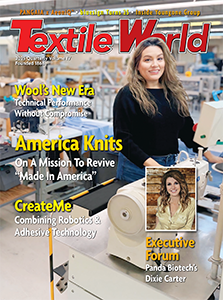 By Jim Borneman, Editor In Chief
By Jim Borneman, Editor In Chief
Despite the chaotic winds encircling U.S. textile Manufacturing, for staunchly committed producers, one can’t help but sense opportunity brewing. Lurking beneath the surface of the divisive tariff uncertainties, a once in a lifetime realignment of the United States’ role in international trade is taking place.
There is ample opportunity for argument, objection and outrage — but one can’t escape the fact that the U.S. position in global production and consumption of goods is changing.
As pundits dissect and prognosticate, real companies, with long track records of innovation and transformation, are on deck adjusting to the opportunities at hand.
For the first time in a very long time, there is a palpable pro-manufacturing environment that is like an exhausted sailor suddenly finding the high winds at their back.
U.S. tax policy and regulatory environments seem to be growing more reasonable, rather than serving as a disincentive to putting capital at risk.
Restoring full expensing of investments— 100-percent depreciation — can offer capital-intensive businesses significant support for investing.
For many who haven’t been able to invest, the dramatic advancements in equipment and technology may have been worth the wait.
By many accounts productivity is poised to skyrocket. Expensive labor has always been an issue in U.S. manufacturing competing in a global market. But most technology has labor cost reduction built in and cost structures seem to be favoring proximity to raw materials, lower energy costs and speed-to-market advantages.
This just may be a recipe for success in the United States and nearshoring manufacturing.
Even for non-yarn spinners, the views of Rieter’s CEO Thomas Oetterli are worth a read (See “Rieter CEO Thomas Oetterli Talks The Future Of Textile Spinning,” TW, this issue). As the leader of one of the most significant suppliers to the global textile industry, Rieter is a barometer on what the future holds in manufacturing.
Oetterli’s takeaways — look for “auto-mated, digital and smart” to lead developments, and labor reduction is baked in.
Oetterli said: “We are stepping up research and development activities to fully automate the value stream by 2027 through autonomous transport systems and collaborative robotics. Rieter’s digital spinning suite ESSENTIAL will be the command-and-control center of smart and high-performing mills that lower cost and maximize returns.”
There are no simple solutions, but one can’t miss the fact that core U.S. textile manufacturers who have made very challenging markets work, will see a favorable shift in competitiveness; an opportunity to meet and exceed their customer’s and consumers’ needs, wants and desires; and an opportunity to establish a new presence in the domestic consumption of U.S. textiles.
Investing in the future of U.S. textiles has never been for the faint of heart — but the business case of capital expenditure has positive support, and for the persistent, there may be no time like the present.
2025 Quarterly Issue III




